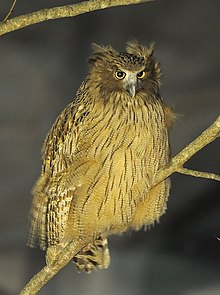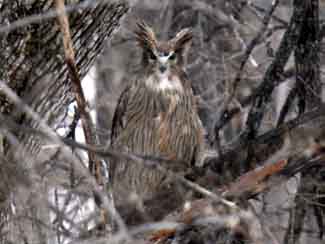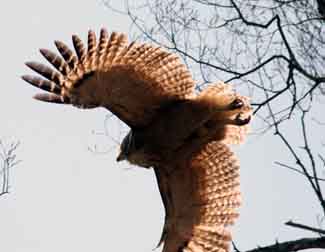Welcome to DU!
The truly grassroots left-of-center political community where regular people, not algorithms, drive the discussions and set the standards.
Join the community:
Create a free account
Support DU (and get rid of ads!):
Become a Star Member
Latest Breaking News
General Discussion
The DU Lounge
All Forums
Issue Forums
Culture Forums
Alliance Forums
Region Forums
Support Forums
Help & Search
Environment & Energy
Related: About this forumIn Russia, Giant Owls Rely on Giant Trees
http://www.wcs.org/news-and-features-main/blakiston-fish-owls-giant-trees.aspx[font face=Serif][font size=5]In Russia, Giant Owls Rely on Giant Trees[/font]
August 15, 2013
[font size=3] The last great primary forests of Russia’s Far East are known for their tigers and bears, but they are also the domain of giant owls. A new study finds that the health of the rare Blakiston’s fish owl is intrinsic to that of these northern forests. The birds rely on old-growth forests along streams for both breeding and to support healthy populations of their favorite prey: salmon.
Large trees provide breeding cavities for the enormous bird, which has a 6-foot wingspan. When these massive trees die and topple into streams, they disrupt water flow, forcing the gushing river around, over, and under these new obstacles. The result is stream channel complexity: a combination of deep, slow-moving backwaters and shallow, fast-moving channels that provide important microhabitats critical to salmon in different developmental stages.
The study, led by WCS and the University of Minnesota, appears in the journal Oryx. The authors studied the foraging and nesting characteristics of Blakiston’s fish owl in Primorye, Russia, where they looked at nesting habitat over 7,804 square miles. They found that large old trees and riparian old-growth forest were the primary distinguishing characteristics of both nest and foraging sites.
The authors say that management and conservation of old-growth forests is essential for sustaining this species because they are central to the owls’ nesting and foraging behavior. Moreover, conservation of Primorye’s forests and rivers sustains habitat for many other species: including eight salmon and trout species that spawn there; some of the 12 other owl species found in Primorye; and mammals like the endangered Amur (or Siberian) tiger, Asiatic black bear, and wild boar. Listed as Endangered by IUCN, Blakiston’s fish owl is restricted to riparian areas in Russia, China, Japan, and possibly North Korea.
…[/font][/font]
August 15, 2013
©Jonathan C. Slaght
A new study shows that Blakiston's fish owls are a clear indicator of the health of the forests, rivers, and salmon populations in Russia’s Far East.
[font size=3] The last great primary forests of Russia’s Far East are known for their tigers and bears, but they are also the domain of giant owls. A new study finds that the health of the rare Blakiston’s fish owl is intrinsic to that of these northern forests. The birds rely on old-growth forests along streams for both breeding and to support healthy populations of their favorite prey: salmon.
Large trees provide breeding cavities for the enormous bird, which has a 6-foot wingspan. When these massive trees die and topple into streams, they disrupt water flow, forcing the gushing river around, over, and under these new obstacles. The result is stream channel complexity: a combination of deep, slow-moving backwaters and shallow, fast-moving channels that provide important microhabitats critical to salmon in different developmental stages.
The study, led by WCS and the University of Minnesota, appears in the journal Oryx. The authors studied the foraging and nesting characteristics of Blakiston’s fish owl in Primorye, Russia, where they looked at nesting habitat over 7,804 square miles. They found that large old trees and riparian old-growth forest were the primary distinguishing characteristics of both nest and foraging sites.
The authors say that management and conservation of old-growth forests is essential for sustaining this species because they are central to the owls’ nesting and foraging behavior. Moreover, conservation of Primorye’s forests and rivers sustains habitat for many other species: including eight salmon and trout species that spawn there; some of the 12 other owl species found in Primorye; and mammals like the endangered Amur (or Siberian) tiger, Asiatic black bear, and wild boar. Listed as Endangered by IUCN, Blakiston’s fish owl is restricted to riparian areas in Russia, China, Japan, and possibly North Korea.
…[/font][/font]
InfoView thread info, including edit history
TrashPut this thread in your Trash Can (My DU » Trash Can)
BookmarkAdd this thread to your Bookmarks (My DU » Bookmarks)
3 replies, 1888 views
ShareGet links to this post and/or share on social media
AlertAlert this post for a rule violation
PowersThere are no powers you can use on this post
EditCannot edit other people's posts
ReplyReply to this post
EditCannot edit other people's posts
Rec (7)
ReplyReply to this post
3 replies
 = new reply since forum marked as read
Highlight:
NoneDon't highlight anything
5 newestHighlight 5 most recent replies
= new reply since forum marked as read
Highlight:
NoneDon't highlight anything
5 newestHighlight 5 most recent replies
In Russia, Giant Owls Rely on Giant Trees (Original Post)
OKIsItJustMe
Aug 2013
OP
clarice
(5,504 posts)1. That's one spooky bird! nt.
happyslug
(14,779 posts)2. More on this owl, the LARGEST Owl in the World
http://en.wikipedia.org/wiki/Blakiston's_Fish_Owl

More on this owl:
http://www.fishowls.com/


http://www.fishowls.com/photos_fishowls.html
These are the LARGEST owls, but not the largest BIRDS that fly:
List of Birds with widest wingspan:
http://www.squidoo.com/top-10-largest-birds-on-earth-wingspans
The largest FLYING bird weighed 150 pounds, but it is believed needed a strong constant wind to take off. When the Andes became to tall, local wind speed fell and thus it could NOT take off and became extinct:
http://scienceblogs.com/grrlscientist/2007/07/02/worlds-largest-bird-was-a-glid/
The Kori Bustard is the heaviest flying bird today. At 40 pounds it has a rough time taking off thus spends 70% of its time on the ground AND prefers to escape its enemies on foot:
http://en.wikipedia.org/wiki/Kori_Bustard
40 pounds is as heavy as a Bird can get AND still be able to get air borne (and that is with difficulty). You need a strong head wind to get airborne if heavier then 30 pounds (Thus Vultures weigh about 5 pounds, for at that weight they can take off with no head wind are every where, Condors, weighting up to 33 pounds needs some head wind to take off, thus restricted to areas with Thermal currents, i.e. the Sierra Madras in the US and the Andes in South America).
http://en.wikipedia.org/wiki/American_Black_Vulture
http://en.wikipedia.org/wiki/Condor
Birds heavier then 40 pounds, are all ground living creatures like the Ostrich (the above huge bird from Argentina is an exception to this rule).

http://www.fishowls.com/


http://www.fishowls.com/photos_fishowls.html
These are the LARGEST owls, but not the largest BIRDS that fly:
List of Birds with widest wingspan:
http://www.squidoo.com/top-10-largest-birds-on-earth-wingspans
The largest FLYING bird weighed 150 pounds, but it is believed needed a strong constant wind to take off. When the Andes became to tall, local wind speed fell and thus it could NOT take off and became extinct:
http://scienceblogs.com/grrlscientist/2007/07/02/worlds-largest-bird-was-a-glid/
The Kori Bustard is the heaviest flying bird today. At 40 pounds it has a rough time taking off thus spends 70% of its time on the ground AND prefers to escape its enemies on foot:
http://en.wikipedia.org/wiki/Kori_Bustard
40 pounds is as heavy as a Bird can get AND still be able to get air borne (and that is with difficulty). You need a strong head wind to get airborne if heavier then 30 pounds (Thus Vultures weigh about 5 pounds, for at that weight they can take off with no head wind are every where, Condors, weighting up to 33 pounds needs some head wind to take off, thus restricted to areas with Thermal currents, i.e. the Sierra Madras in the US and the Andes in South America).
http://en.wikipedia.org/wiki/American_Black_Vulture
http://en.wikipedia.org/wiki/Condor
Birds heavier then 40 pounds, are all ground living creatures like the Ostrich (the above huge bird from Argentina is an exception to this rule).
Nihil
(13,508 posts)3. Big owls and tigers and bears. Oh my!
Best of luck to the owls (and the tigers and the bears and the scarecrows and ...)
